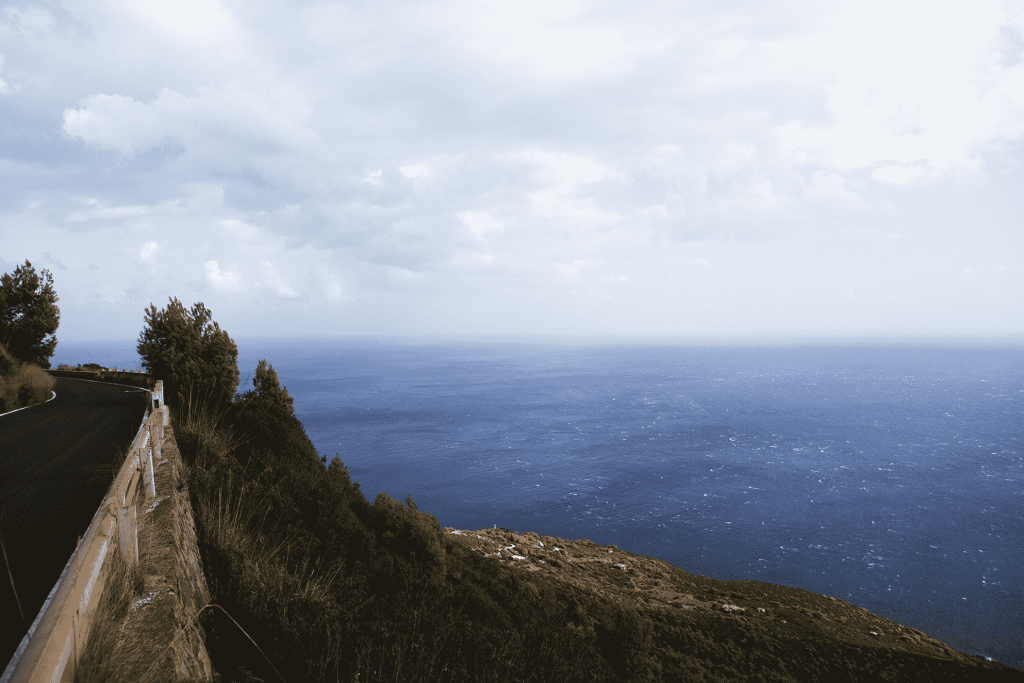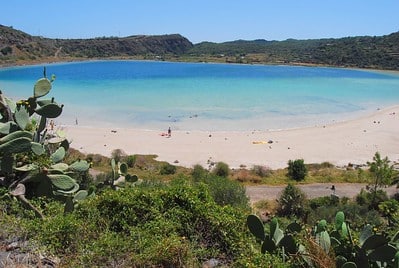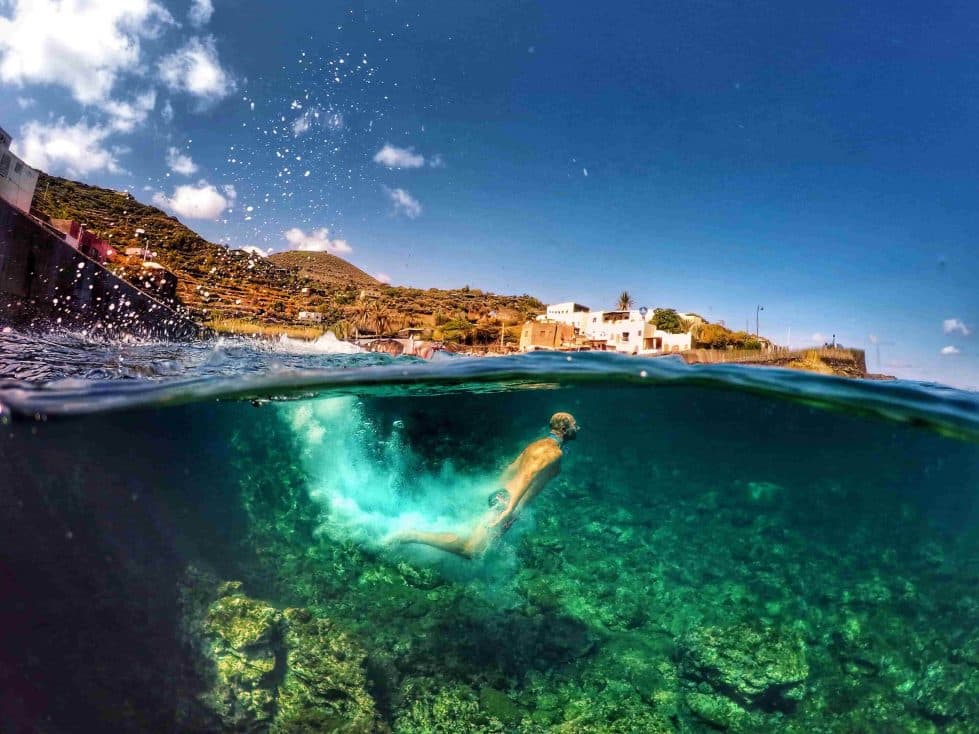This article originally appeared in the August/September 2020 issue of Dream of Italy. Join Dream of Italy as a member to access this issue and 180+ back issues.
I first read about the island of Pantelleria in 1989. The writer referred to it as “a speck between Sicily and Africa,” and added, “Pantelleria feels as if it was formed only a week ago last Thursday” and that the islanders (known as Pantescans) “seem in no hurry to become modern,” all of which intrigued me.
In the years since, Pantelleria has been described as “The Mediterranean’s Last Great Unspoiled Destination,” “Italy’s Anti-Capri” and “Italy’s Most Fantastically Awesome Island You Didn’t Know About.” Even now, after a handful of celebrities and the 2015 filming of the movie A Bigger Splash brought the island some fame, it’s still not exactly on the map: not a single person had heard of it when I mentioned I was going last fall.
It’s perhaps best to state early on that Pantelleria, which was created by volcanic eruptions almost 300,000 years ago, is not for everyone. It is everything that the chic ports of call elsewhere in Italy—Portofino, the Amalfi Coast, Lake Como—are not. There are no beaches on the entire island, and its landscape is a rugged mix of black lava shapes, dramatic and jagged cliffs that descend straight into the sea, hot springs, a thermal lake, the occasional palm tree, terraced farms, and low-lying macchia, densely packed and aromatic shrubs.
Yet Pantelleria is stunningly beautiful, and its laid-back vibe and utter lack of pretension is precisely what has attracted Madonna, Sting, Gerard Depardieu, New York City specialty food retailer Eli Zabar, Italian photographer Fabrizio Ferri, Cate Blanchett, French actress Carole Bouquet (who owns a wine estate) and Giorgio Armani, who has been a part-time resident since the early 1980s. A visit to Pantelleria feels like you have gone somewhere very far away.
And it is far, over 60 miles from the southwest coast of Sicily and 37 miles from Tunisia, and is a bit hard to reach (two or three flights or a boat from Trapani, Sicily). But after the journey to get there the sense of tranquility and the relaxed pace is immediate.

Stonewall Lined Road
Narrow Roads Lined with Stonewalls
The island is only 32 square miles so it doesn’t take very long to get anywhere, and if there is a stoplight on the island I never saw one, but the main reason visitors experience the island slowly is that many of the roads are very narrow. They’re also lined with stone walls that have prickly pear and bougainvillea cascading over them, so driving fast isn’t an option, and mere inches are between any passing vehicle other than a scooter.
In daylight, the driving’s fine, but once the sun goes down it’s quite a different story. My friend and I rented a car, and we left at dusk to go out for dinner on our first night. It took just 12 minutes to reach the restaurant, but we neglected to pay close attention to the route, and many hours later we discovered there were not many street lights and we could not find our way back as all the roads looked the same.
Our cell phone’s power was nearly gone, and after driving around for 30 minutes, we saw some policemen who were directing traffic after a concert, and my friend asked (in Italian) for directions. We set out again for another 30 minutes and just as we’d decided that we were going to have to call it quits and find a hotel in Pantelleria Center, we saw a sign we’d missed previously and finally made it back at midnight. From then on, we took note during the day of all landmarks and switchbacks.
The Winds Bring Bounty
Pantelleria was occupied by north African Arabs for many years, and one source of the island’s name is Bentel Riah, Arabic for Daughter of the Wind (many words in the Pantescan dialect are of Arab origin, like the hamlets of Bukkuram, Rakhali, Gadir, etc.). The maestrale or sirocco winds swirl around the island 337 days of the year, which is why flights can be delayed or cancelled (planes at the airport sometimes have to be tied down or they’ll blow over).
The winds also dictate how the island’s olives and Zibibbo grapes, used to make Passito di Pantelleria, are grown, which is low to the ground akin to bonsai. In 2014, the Zibibbo practice of head-trained bush vines (vite ad albarello) was recognized by UNESCO, which also recognized, in 2018, the art of the island’s dry-stone walls. It may seem improbable that they grow here at all, on an island with no fresh water source and little rainfall, but the volcanic soil is fertile, and capers, too, thrive here.
Pantelleria capers are widely considered the world’s best, and they are the only Italian capers with the Indicazione Geografica Protetta designation. They’re packed in sea salt (no spare water for curing) and are a perfect souvenir (a great place to buy them is the Cooperativa Agricola Produttori Capperi, where plenty of locals buy them, too). Every single olive, grape and caper is picked by hand, one by one.

Dammusi, Photo Credit: Luca Conti, flickr.com
Pantelleria’s Dammusi
Not long ago, apart from some decidedly average hotels in the center, most visitors stayed in dammusi (singular dammuso), cubic stone dwellings with domed roofs dating back to the 10th century that have become the architectural symbol of Pantelleria. The word’s origin may be from the Latin domus (house) or the Arabic dammus (vaulted building).
The one-level dammusi are often black due to the use of volcanic rock in their construction, thus the island’s “Black Pearl of the Mediterranean” moniker, and they have exceptionally thick walls that keep them cool in the summer and warm in the winter. The painted white lines on the domes may appear to be merely decorative but they are a brilliant method of collecting rainwater, which flows to a nearby cistern.
Dammusi are still a popular accommodation choice, and the best known on the island are those of the Tenuta Borgia estate, where A Bigger Splash was filmed. What was once a summer retreat for Milanese proprietor Rosa Borgia Baroness Collice is now a 27-acre property: when neighboring properties were up for sale, she bought them to prevent their demolition and to preserve her surroundings.
There are seven individual dammuso that accommodate from two to eight people (the entire estate sleeps 24 people, perfect for any kind of reunion or celebration). My friend and I stayed at Limoni, which consists of two dammusi, a separate kitchen, outdoor dining area, and a small pool.
Borgia worked with architect Gabriella Giuntoli, who lives on the island and has been referred to as the “savior of Pantelleria”, for the restoration. (Giuntoli also restored Armani’s dammuso, among many others). Each dammuso is rustic and stylish in an agriturismo kind of way (appropriate as the estate is also a farm producing olives and grapes) and overall the effect is eclectic—there are aquatic light fixtures of hand-blown glass in the Dammuso Grande mixed with antiques, all personally selected by Borgia.
The estate also has one of the best examples of a giardino Pantesco (or jardinu in local dialect; also called an Arab garden) on the island. These are composed of stone walls that typically enclose citrus trees, and they’re built at a specific height to protect the trees from the wind while still allowing for sufficient sun.
There are a few distinctive hotels on Pantelleria but none capture so perfectly the island’s sense of place than Sikelia. Owner Giulia Pazienza Gelmetti, who in a previous life was a professional basketball player, first came to Pantelleria in 2000 and was smitten. She’d wanted to open a hotel for many years, and when an old villa built in the traditional local style was up for sale, she felt it was the right opportunity. Gelmetti says her vision was a place “that when you close the door, you feel the space, the sunset, the stars, and the silence of Pantelleria.”
She also enlisted architect Giuntoli as she wanted a partner who was equally respectful of Pantelleria’s natural features. Sikelia’s 20 suites, converted dammusi, are all unique but each exudes the look and feel of the island: a color palette of gray, gold, black, silver, beige, white, and purple mixes perfectly with bronze and other metals, as well as glass, and texture is everywhere – in patterned metal artworks, plush velvet chairs, natural fiber rugs, coral vases, and carved wooden tables on terraces.
The décor is minimalist but Frette linens, Gessi fixtures, Hermès toiletries, Harmon Kardon speakers, and attention to the small details insure a luxurious stay. The hotel’s restaurant, Themà, turns out dishes that blend Sicilian, North African, and local flavors under the direction of chef Diego Battaglia. It is sheer bliss eating at one of the outdoor tables. The capers and bread, made on site, are outstanding.
Gelmetti also owns three wine estates, and the one nearest Sikelia is Coste Ghirlanda, where a pop-up restaurant, Officina, is open in the summer. A wine tasting I attended there was positively magical. It was held outdoors in the early evening and there were twinkling lights all around the estate, which is set in a valley overlooking the plain of Ghirlanda, in the center of the island. Themà manager Angelo poured a series of excellent wines while the sky above changed from fiery red and orange to lilac.
Aside from annual Carnevale celebrations, feast days, a regatta, and some concerts and festivals, there’s not much happening on Pantelleria and the only cultural must-see is La Collina di Loredana, an open-air museum with 25 installations by contemporary artists, most created in situ.
Pantelleria Town was heavily bombed by the Allies in 1943 so it doesn’t hold much appeal, though the Castello Barbacane, of Byzantine origin, is well preserved and is slated to become a museum; there are also a few good shops and restaurants as well as one of the island’s two gas stations. But the island’s outdoor pursuits are its star attractions.

Lago Specchio di Venere, Photo Credit: mauro, flickr.com
Outdoor Life
The Lago Specchio di Venere (Mirror of Venus Lake) is a deep, thermal lake with nutrient-rich mud and it has a beach around most of it. The Neolithic village and tombs known as the Sési, dating from about 5,000 years ago, are fascinating and are considered one of the most important archeological sites in the Mediterranean.
Picturesque sites along the coast road include Arco dell’Elefante, Salto la Vecchia and Cala Cinque Denti, and many of the roads that descend from the coast road lead to swimming spots—the Pantescans have cleverly built wooden platforms over the rocky shoreline with ladders into the sea.
There are hiking trails galore and the Montagne Grande (the island’s highest peak) as well as diving and boating opportunities. Stepping into the fine giardino Pantesco (or jardinu in local dialect; also called an Arab garden) at the Donnafugata winery is also a singular experience – this type of garden is composed of stone walls that typically enclose citrus trees, and the walls are built at a specific height to protect the trees from the wind while still allowing for sufficient sun. Donnafugata’s garden is circular and contains a single orange tree inside (sipping the winery’s Ben Ryé Passito at a tasting is an equally pleasant pursuit).
Still, the best thing to ‘do’ on Pantelleria is settle into the languorous rhythm and plan your days around meals and sunsets, which are among the most memorable you’ll ever see. Pack a carry-on bag, fill it with your favorite casual clothing, and leave the jewelry and digital calendar behind.
Giulia Gelmetti notes there is a local saying that once you have spent a bit of time on Pantelleria, you realize you really don’t need anything else. I’m now an official believer in this saying, and am counting the days when I’ll return to this matchless Italian island.
—Barrie Kerper
Getting There and Around
Arriving by air: A number of European airlines fly to Catania, Trapani, and Palermo where connections may be made for Pantelleria. I flew back to Palermo from Pantelleria on DAT (www.dat.dk), which also has flights from Catania and Trapani (flight time between Palermo and Pantelleria is 45 minutes). Within Italy, Volotea (www.volotea.com) has flights from Genoa, Torino, and Venice.
Arriving by sea: Liberty Lines (www.libertylines.it) offers ferries and hydrofoils between Trapani and Pantelleria and is the best option among the other lines, which take longer and whose boats are older.
Car Rental:
Policardo
Via Messina, 31
(39) 0923 912844
www.policardo.it
Boat, kayak, and mountain bike rentals:
Viva Pantelleria
Piazza Messina, 18
(Pantelleria Town)
(39) 328 3889893
www.vivapantelleria.it
Trekking excursions also arranged as well as transfer services.
Find out more at www.pantelleria.com
Where to Stay
Sikelia
Via Monastero
(39) 0923 408120
www.sikeliapantelleria.com
Open April to October.
No children under age 12.
Rates: Half-board from 560 to 1,700€; bed and breakfast rates from 440 to 1,580€.
Tenuta Borgia
Salto La Vecchia
www.tenutaborgia.it
Rates: From 650 to 9,20€0 per week.Inquire directly about nightly rates and the price for the entire estate. (If mosquitos like you, bring repellant.)
Other Dammusi Rental Agencies:
InSicily
www.insicily.com
Relais Euterpini
www.euterpini.com
Solopantelleria
www.solopantelleria.com
Where to Eat
Themà at Sikelia is open to non-guests and it is sheer bliss eating at one of the outdoor tables. The ricotta and mint ravioli and pesto Pantescan are stand-outs and don’t miss the capers and bread, made on site. Sikelia guests may dine at the Coste Ghirlanda Officina at any time (shuttle service provided); non-guests are welcome at the pop-up restaurant from July to late September.
Il Gabbiano Azzurro
Via Trieste, 5
(Pantelleria Town)
(39) 0923 911909
Somewhat of an old-fashioned place serving traditional local dishes. Good caponata, not-so-good fried calamari. Good for long, relaxing meals as the service is not speedy.
Osteria Il Principe e Il Pirata
Strada Punta Karace
www.ilprincipeeilpirata.it
(39) 0923 691108
Inventive and delicious dishes, mostly seafood, with local ingredients. The fish and vegetable couscous is terrific, as is the outdoor seating. With notice from both Michelin and Slow Food, this may be the best restaurant on the island.
Ristorante La Nicchia
Contrada da Scauri
(Scauri Basso)
(39) 0923 916342
Everyone ends up at La Nicchia eventually. Lively atmosphere with outdoor and indoor seating (tables are set around an orange tree). Great grilled whole fish and insalata Pantesca (potatoes, tomatoes, red onion, olives, and capers, naturalmente).
Panificio Gelateria Katia
Lungomare Paolo Borsellino, 84
(Pantelleria Town)
Really good gelato and also a great place to try the bacio Pantesco (Pantescan kiss), a fried waffle confection with a filling of ricotta, chocolate chips and cinnamon (trust me, it’s worth the calories).
Where to Shop
Nota bene: Many shops and services in Pantelleria Town close between 1:00 and 5:00 p.m.
Casbah
Two locations:
Piazza S. Gaetano, 73 (Scauri)
Via Trieste, 1
(Pantelleria Town)
Appealing boutique with cool cotton clothing, interesting jewelry, gifts, cotton sheets for the beach or al fresco picnics in Casbah-logo drawstring bags. The Pantelleria Town location is small while in Scauri there are two shops, one devoted to colorful ceramics.
Cooperativa Agricola Produttori Capperi
Via del Cappero, 11
(Scauri Basso)
www.capperipantelleria.com
Bags of capers are 2.50 to 12€ No mail orders filled outside Italy, but capers from La Nicchia, a noted producer since 1949, are available from its online shop, www.lanicchia.com; Eataly (www.eataly.com) and Zingerman’s (www.zingermans.com)
Emporio del Gusto
Via Napoli, 9
(Lungomare, Pantelleria Town)
www.emporio-gusto.com
Good selection of quality culinary provisions, wine, local ceramics, books, and gifts.
Sottovento
Via Borgo Italia
(Pantelleria Town)
Stylish women’s clothing.
What to Read
Admiring Pantelleria
Giuseppe Julio Rodo
EBS print, 2019
Available at the Pantelleria airport and in some shops, this is a “Guide Book with Paths, Places, Photos, and history of the Island” by a local resident who is passionate about his home. The English translation is not always perfect, but it’s a comprehensive book with lots of photos (some of Pantelleria Town before it was bombed) and a pull-out map. Rodo also offers personal panoramic tours of the island: www.bit.ly/pantbook
Mediterranean Living
Lisa Lovatt-Smith
Watson-Guptill, 1998
The cover photo is of the patio at Giorgio Armani’s dammuso on Pantelleria and the first home profiled in the book is his. The author writes, “this tiny windswept island is a minuscule domain unto itself” and “the landscape is rugged, and the local architecture unlike anything seen elsewhere.” Aside from this mention of Pantelleria the book is a beautiful, passionate love letter to the Mediterranean.

